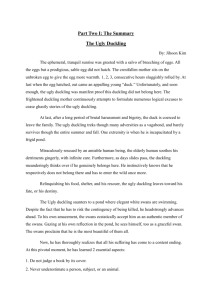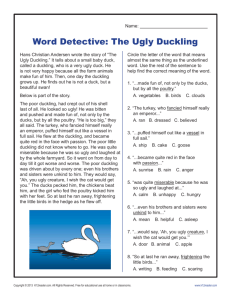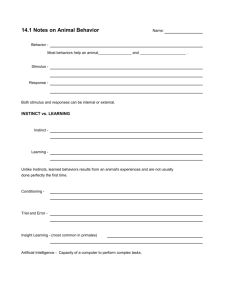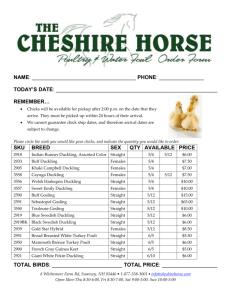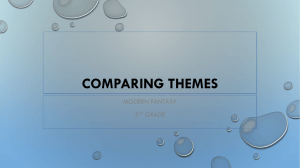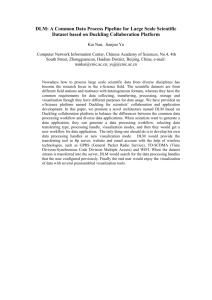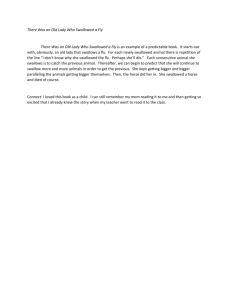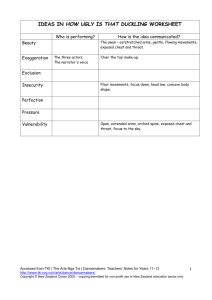"The Ugly Duckling" Study Guide for Teachers and
advertisement
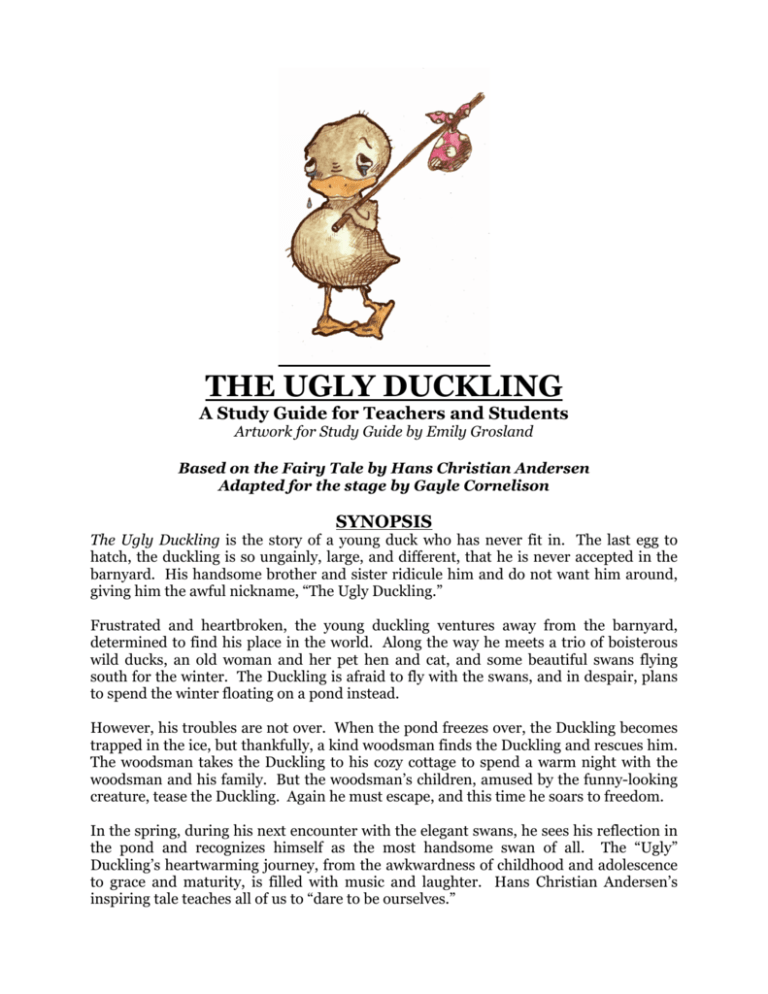
THE UGLY DUCKLING A Study Guide for Teachers and Students Artwork for Study Guide by Emily Grosland Based on the Fairy Tale by Hans Christian Andersen Adapted for the stage by Gayle Cornelison SYNOPSIS The Ugly Duckling is the story of a young duck who has never fit in. The last egg to hatch, the duckling is so ungainly, large, and different, that he is never accepted in the barnyard. His handsome brother and sister ridicule him and do not want him around, giving him the awful nickname, “The Ugly Duckling.” Frustrated and heartbroken, the young duckling ventures away from the barnyard, determined to find his place in the world. Along the way he meets a trio of boisterous wild ducks, an old woman and her pet hen and cat, and some beautiful swans flying south for the winter. The Duckling is afraid to fly with the swans, and in despair, plans to spend the winter floating on a pond instead. However, his troubles are not over. When the pond freezes over, the Duckling becomes trapped in the ice, but thankfully, a kind woodsman finds the Duckling and rescues him. The woodsman takes the Duckling to his cozy cottage to spend a warm night with the woodsman and his family. But the woodsman’s children, amused by the funny-looking creature, tease the Duckling. Again he must escape, and this time he soars to freedom. In the spring, during his next encounter with the elegant swans, he sees his reflection in the pond and recognizes himself as the most handsome swan of all. The “Ugly” Duckling’s heartwarming journey, from the awkwardness of childhood and adolescence to grace and maturity, is filled with music and laughter. Hans Christian Andersen’s inspiring tale teaches all of us to “dare to be ourselves.” CREATIVE WRITING/DISCUSSION 1. Have students write about a time when they felt like they didn’t fit in. Share them with the class if they feel comfortable. 2. Was the duckling actually ugly? Were there any characters in the story that were truly ugly? If so, what made them ugly? 3. Acceptance is a major theme in this story. Why did the duckling not feel welcome in the barnyard or in the old woman’s house? Why did the wild ducks and the swans seem to accept the duckling and why did they invite him to join them? 4. Who was kind in the play? Who was unkind? LITERATURE 1. Read a storybook version of Hans Christian Andersen’s “The Ugly Duckling” with your class. Compare and contrast the written story with the play. Research Andersen’s life, including information on his other works, his home in Denmark, and the period in which he lived. 2. Compare the story of “The Ugly Duckling” to other Hans Christian Andersen tales, such as “The Little Mermaid,” “The Emperor’s New Clothes,” “The Princess and the Pea,” “Thumbelina,” “The Nightingale,” etc. 3. Have students pick an animal from the story and find fun facts about that animal on the Internet. ART 1. Why do you think the humans in the play wear masks? Have students select an animal character from the play and create a mask for that character. 2. Have students create masks for a real animal of their choosing. Have them “become” the animal, with specific character traits, movements, and sounds. 3. As a class, make a mural of a barnyard scene. Use all the animals in the story, and any other additions you would like to make. SOCIAL STUDIES 1. Our hero the Duckling is not alone in feeling like he doesn’t belong. Discuss historical figures who probably felt like outsiders and succeeded, despite the skepticism of other people. Possible subjects are Susan B. Anthony, Christopher Columbus, Leonardo da Vinci, Frederick Douglass, Amelia Earheart, Anne Frank, Galileo, Helen Keller, Harper Lee, Jackie Robinson, The Wright Brothers. 2. The ducks in the play fly south for the winter. Look on a map with the class and trace a possible route from a cold climate to a warmer one. Discuss why birds make this journey every year. SCIENCE 1. Research and discuss life cycles and how animals mature. Have students create a chart depicting the different stages of an animal’s life. Do one for several animals. 2. The changing seasons play an important role in play The Ugly Duckling. Research and compare the four seasons, including how they affect animals, plant life and the weather. 3. Have students find out what we call the following animal babies: geese, swans, sheep, horses, cows, goats, chickens, pigs, dogs, cats, butterflies, frogs. Divide students into groups and assign 3-4 animals to each group. WRITE TO CTC! After watching the play, write about it. Tell what you liked or disliked about the story, the characters, costumes, set, or anything else you observed. Support your thoughts with examples and reasons. (Teacher’s comments are appreciated!) Mail to: CTC, P.O. Box 2007 Sunnyvale, CA 94087 READING SUGGESTIONS • The Ugly Duckling by Hans Christian Andersen, adapted and illustrated by Jerry Pinkney. HarperCollins, 1999. • The Ugly Duckling by H.C. Andersen, illustrated by Robert Ingpen. Minedition, 2005. • The Ugly Duckling (Easy-to-Read) adapted by Emily Bolam and Harriet Ziefert. Puffin, 1997. • The Stories of Hans Christian Andersen: A New Translation from the Danish. Translated by Diana Crone Frank, illustrated by Jeffrey Frank, Diana Frank, Vilhelm Pedersen, Lorenz Froelich. Houghton Mifflin, 2003. • The Classic Treasury of Hans Christian Andersen by H.C. Andersen, illustrated by Christian Birmingham. Courage Books, 2002.

